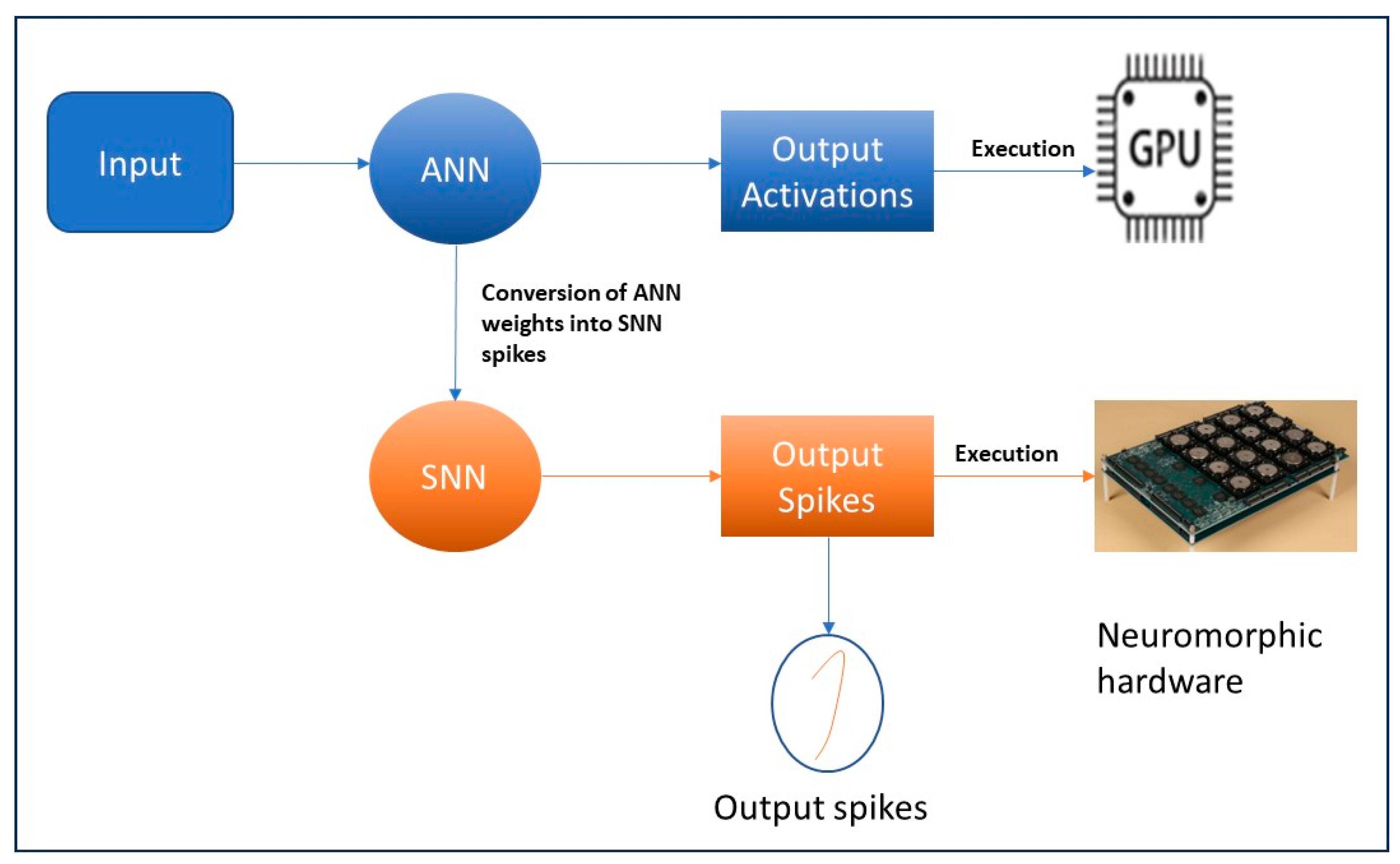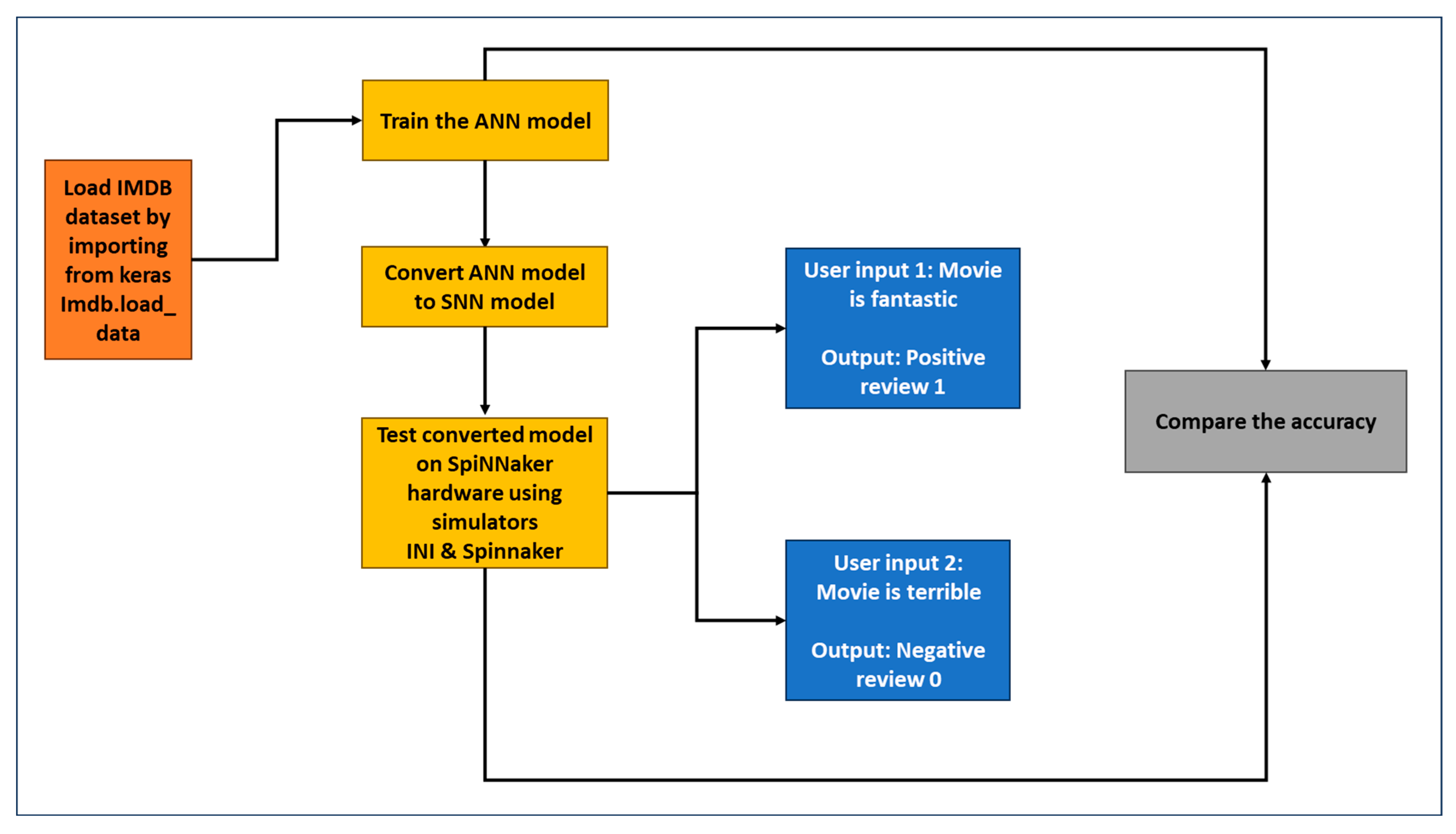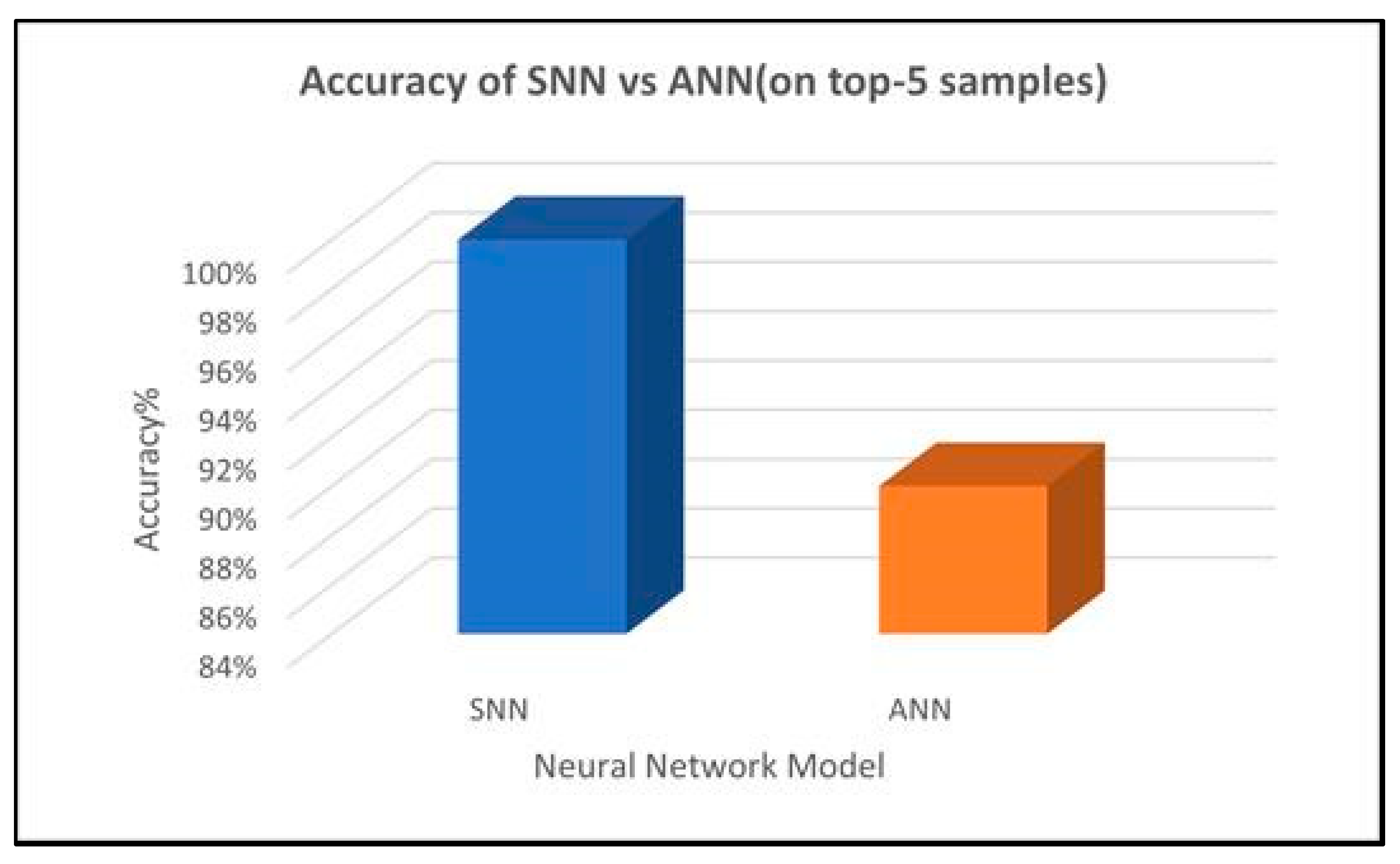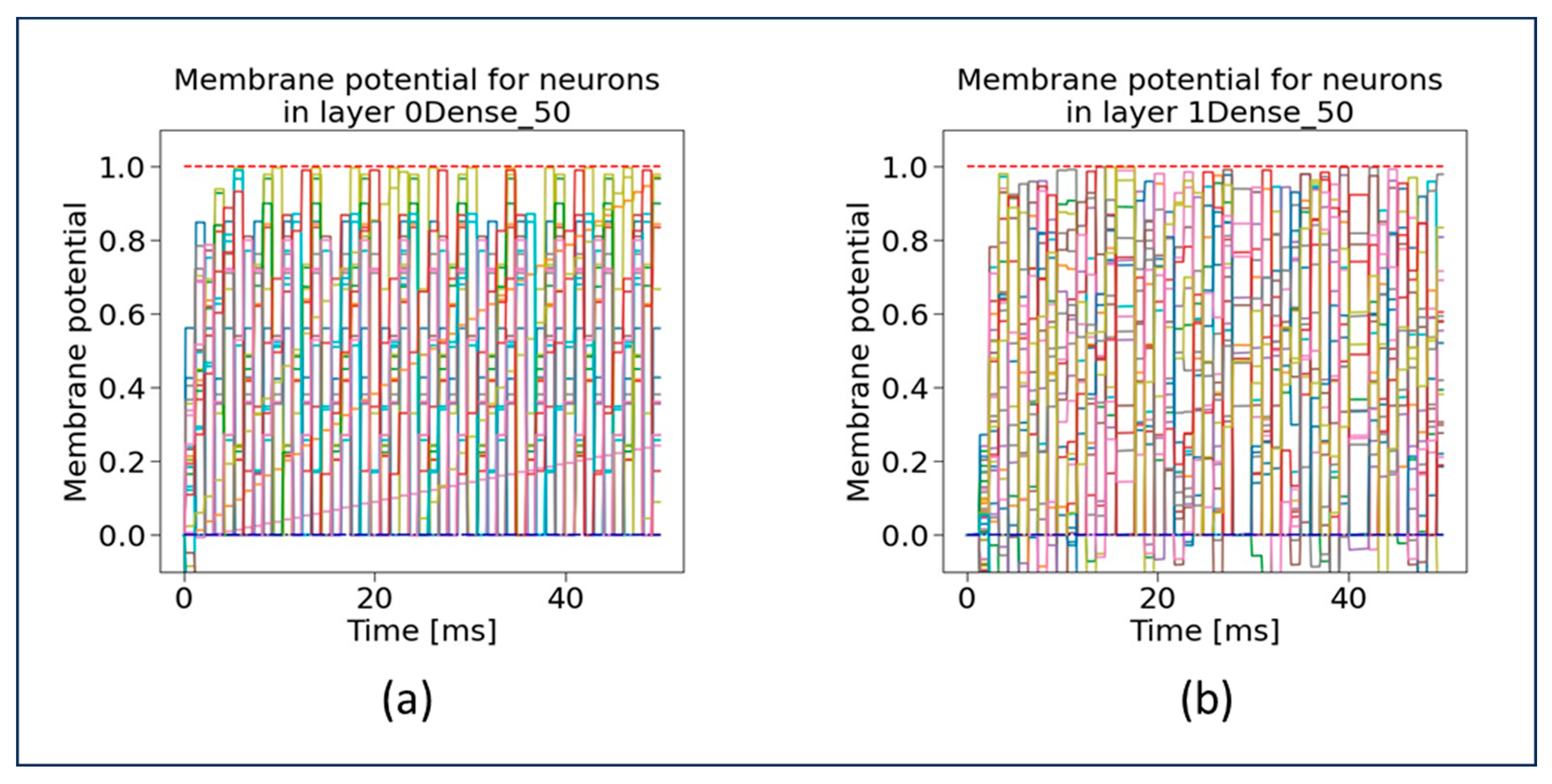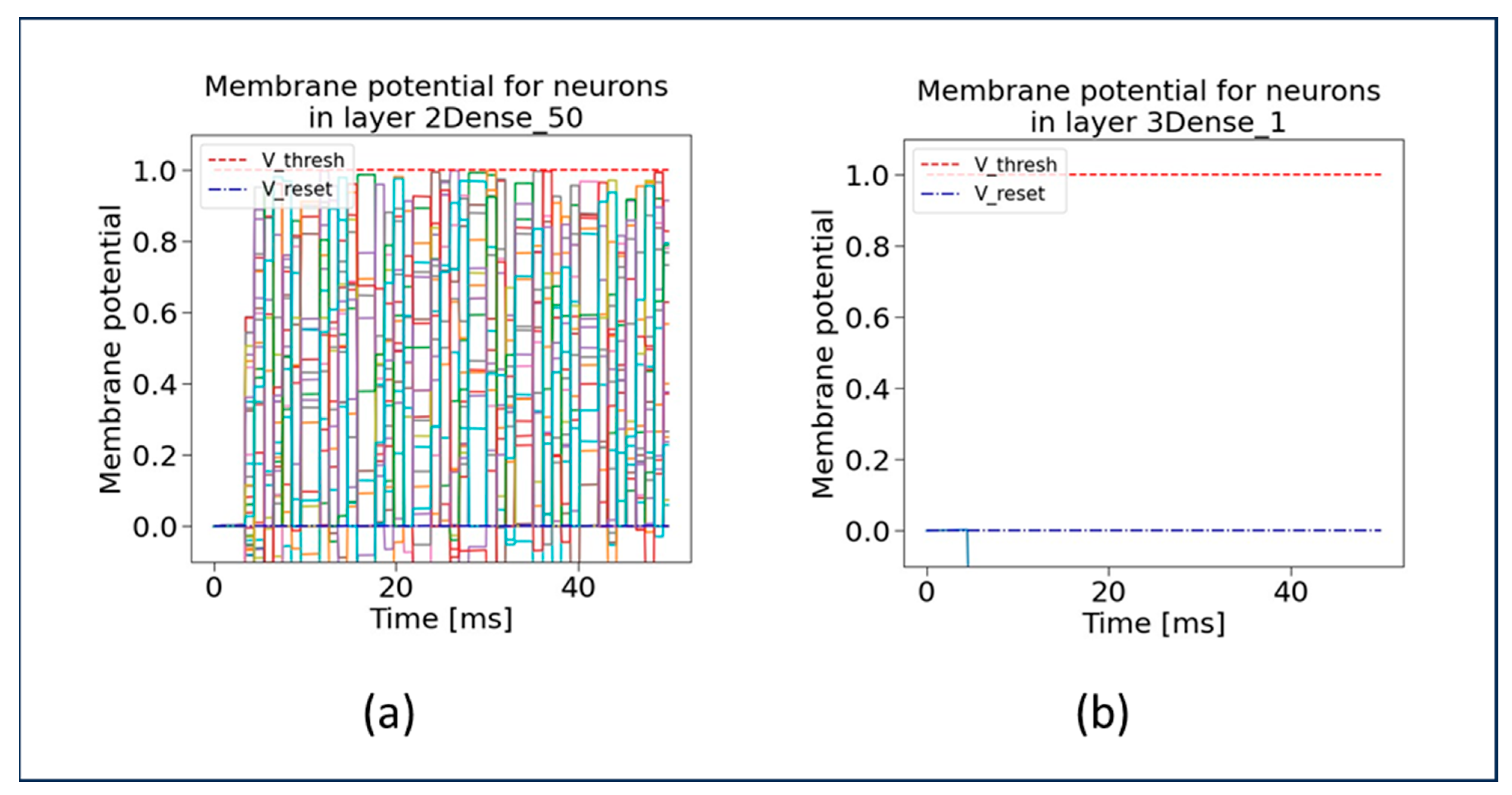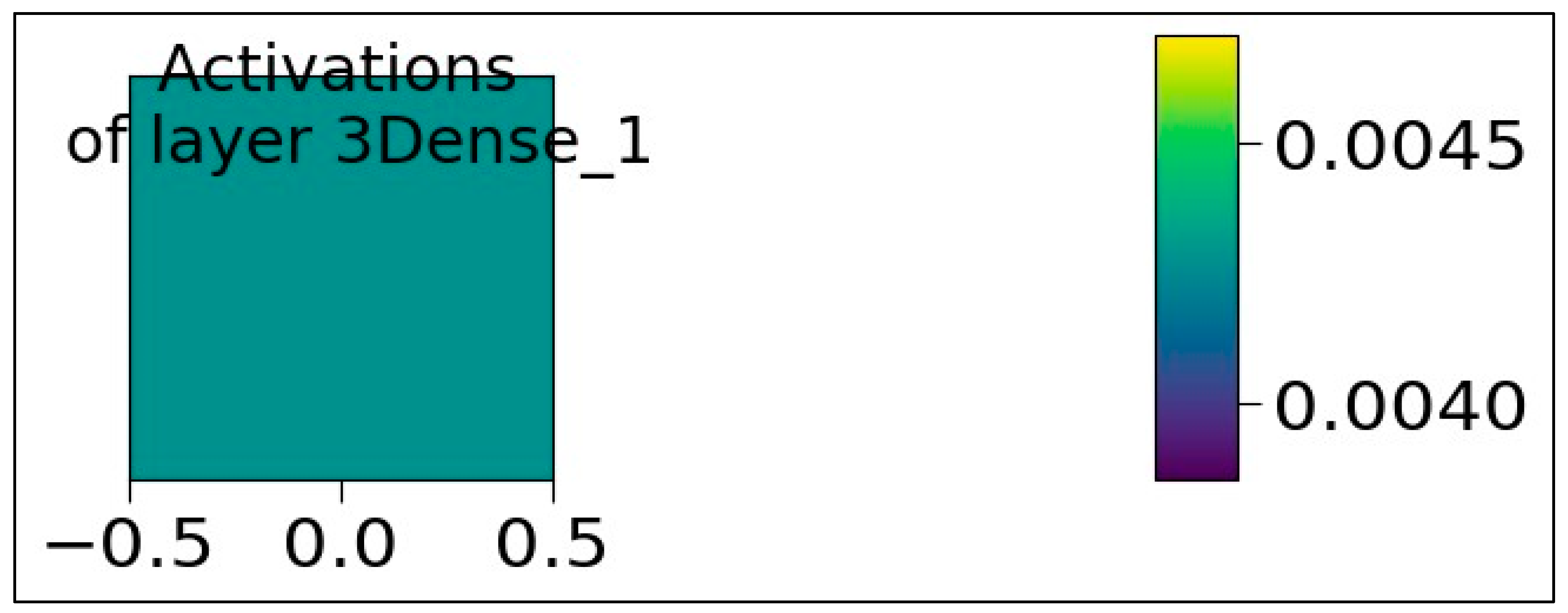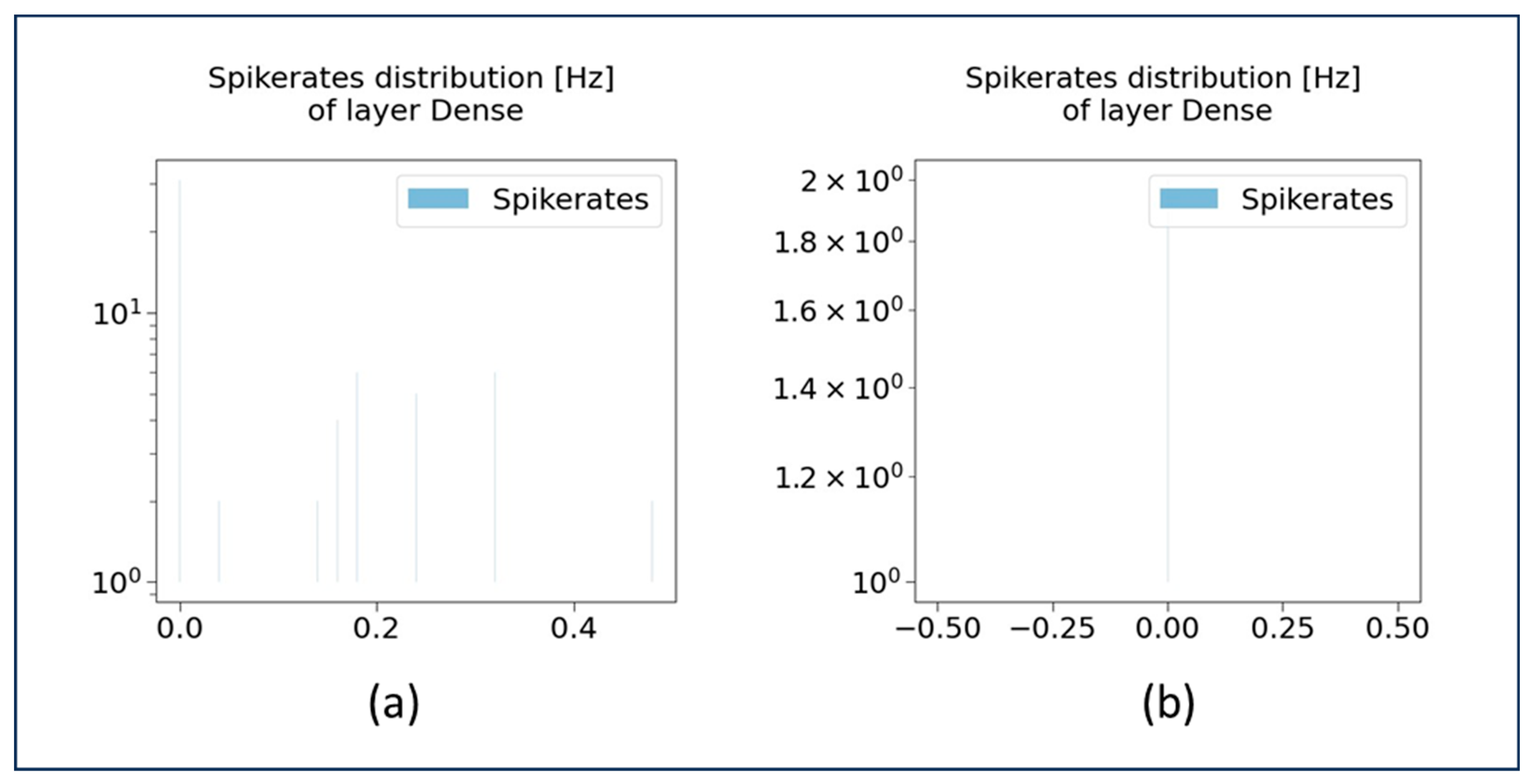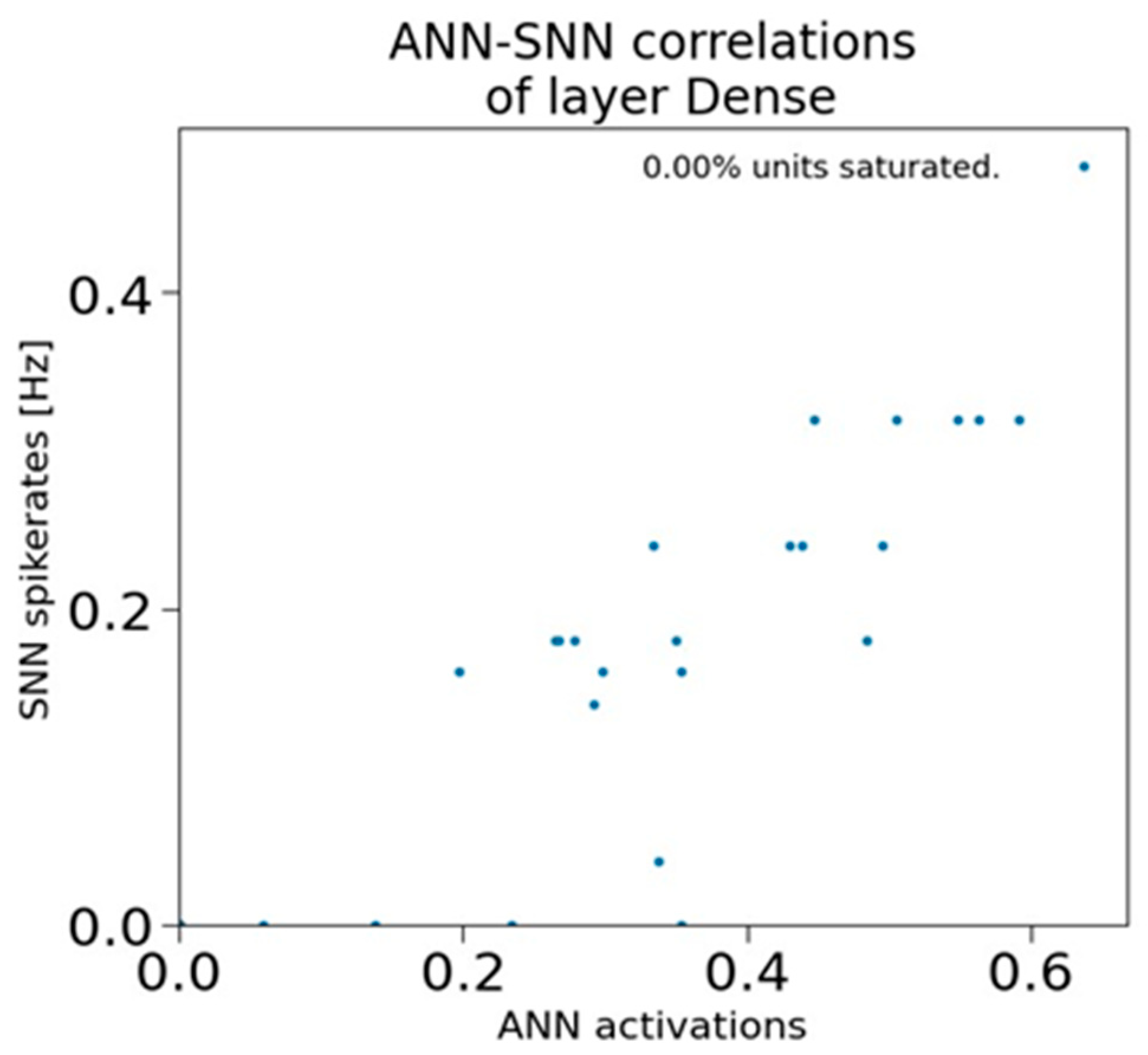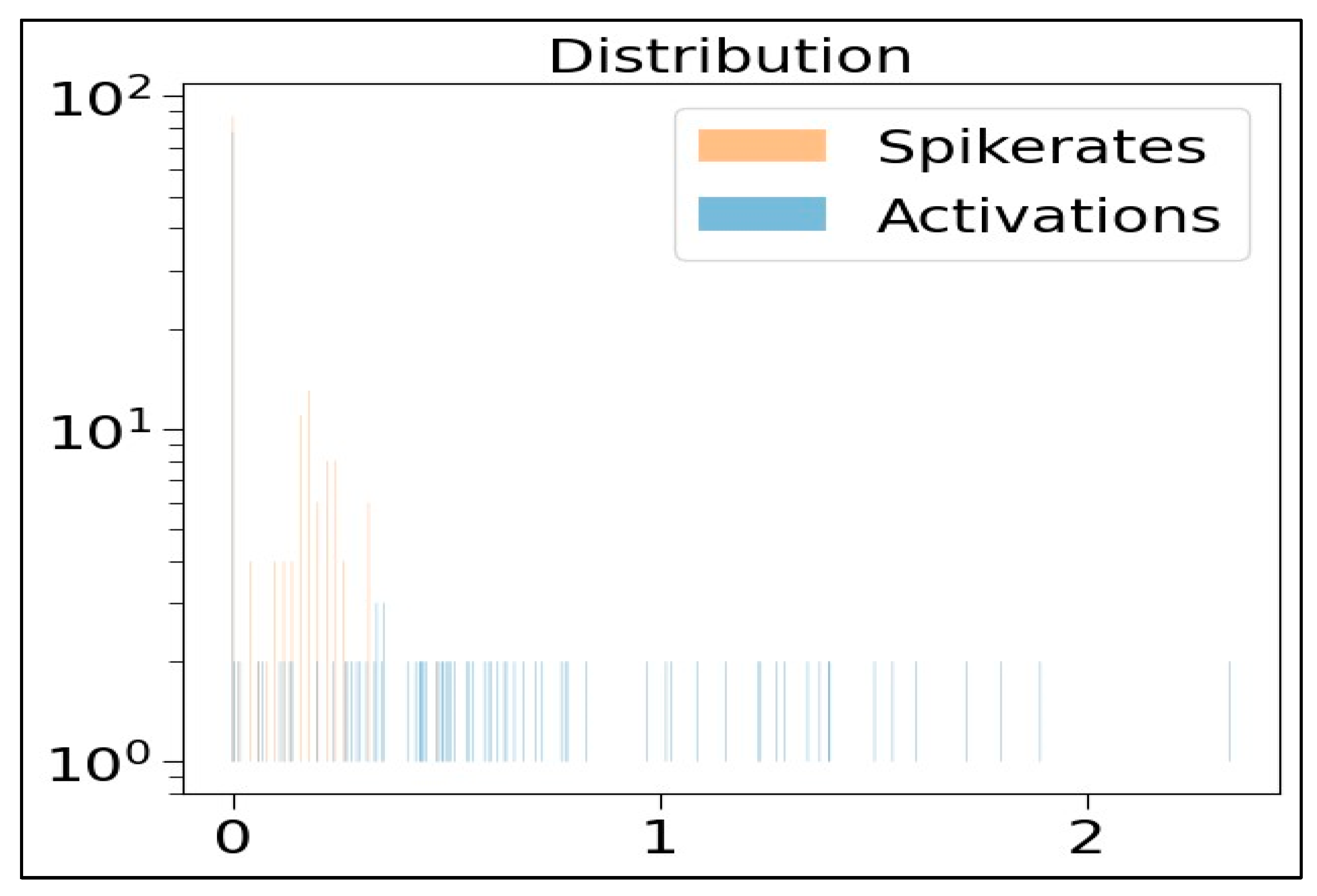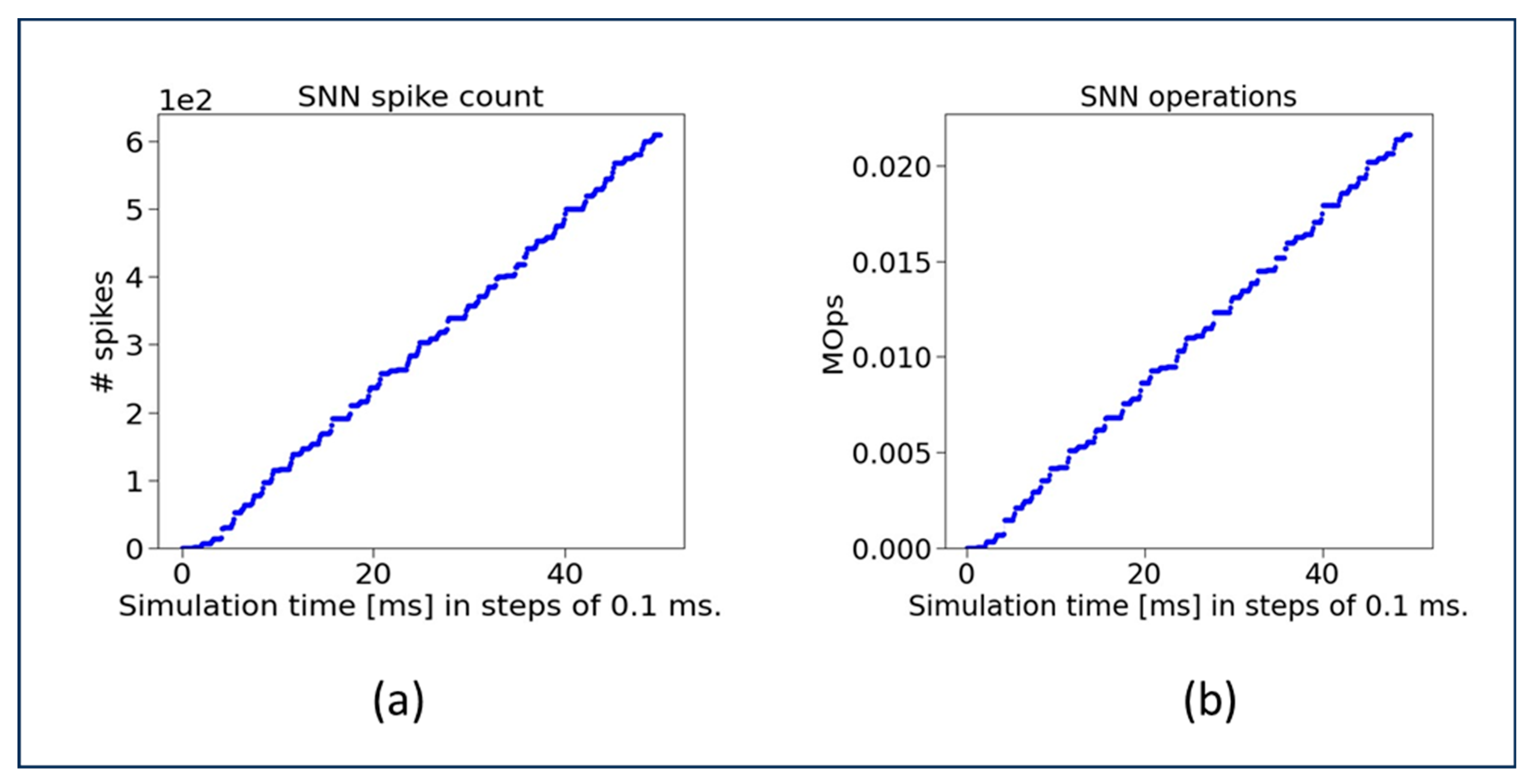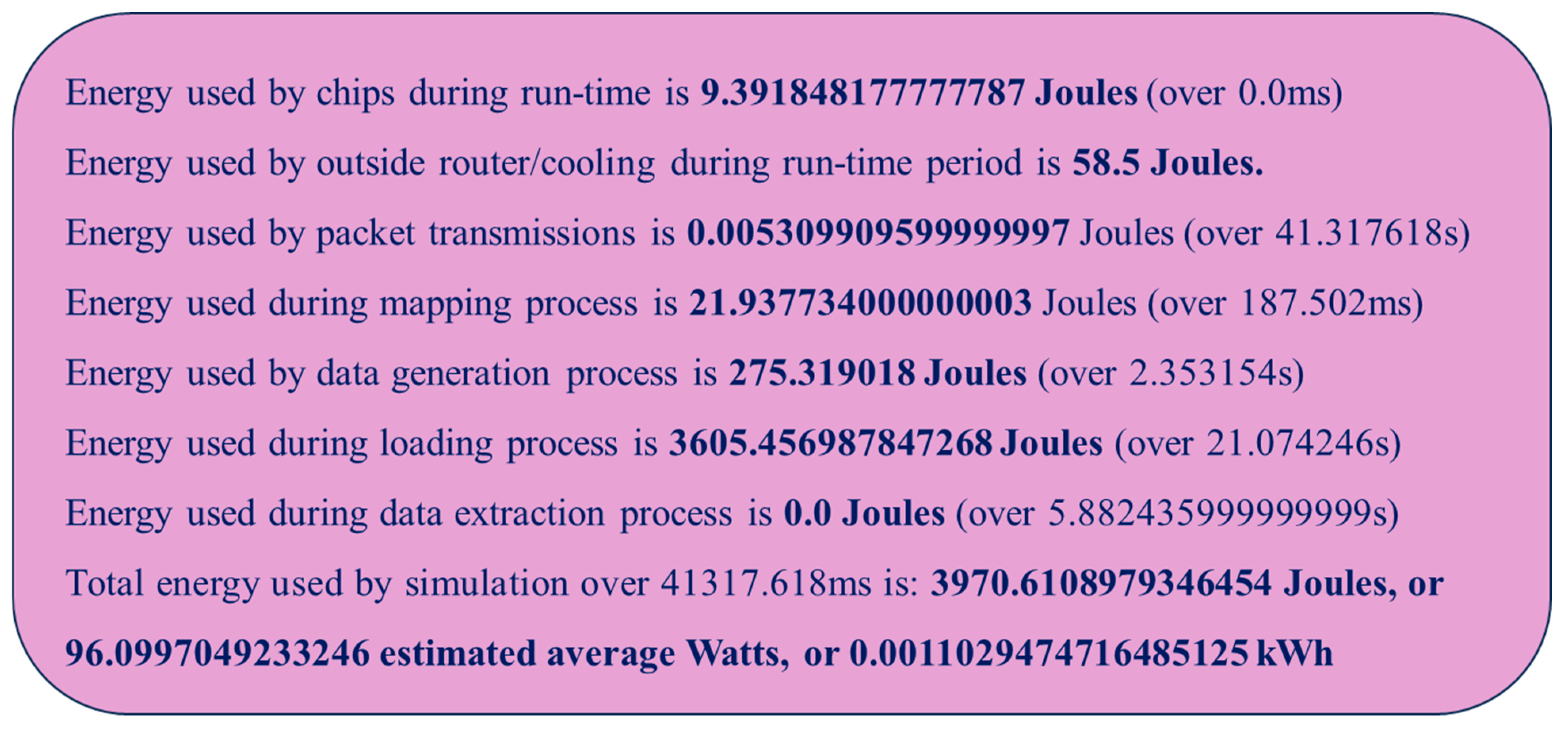1. Introduction
In recent years, the Artificial Neural Networks (ANNs) domain has witnessed a significant adaptation of Deep Neural Networks (DNNs) across several fields, such as machine learning, computer vision, artificial intelligence, and natural language processing (NLP). DNNs are capable of accurately performing a wide range of tasks by training on massive datasets [
1]. However, the energy consumption and computational cost required for training large volumes of datasets and for deploying the resulting applications have been of less importance; thus, they have been overlooked [
2,
3]. The DNNs typically consume high power and require large data storage [
4,
5]. Although there have been significant advancements in ANNs, ANNs were unable to achieve the same level of energy efficiency and online learning ability as biological neural networks [
6]. Drawing inspiration from brain-inspired computing, one potential solution to address the issue of high-power consumption is to use the neuromorphic hardware with Spiking Neural Networks (SNNs). SNNs, often considered the third generation of neural networks, are emerging to bridge the gap between fields such as machine learning and neuroscience [
7].
Unlike traditional neural networks that rely on continuous-valued signals, the SNNs work in continuous time [
8]. In SNNs, the neurons communicate with each other using discrete electrical signals called spikes. Spikes model the behavior of the neurons more accurately and more biologically plausible than ANNs, thus making SNNs more energy efficient and computationally powerful than ANNs [
9]. The neuron models of ANNs and SNNs differ from each other. For instance, ANNs do not have any memory and use sigmoid, tanh, or rectified linear unit (ReLU) as computational units, whereas SNNs have memory and use non-differentiable neuron models. Typically, large-scale SNN models consume high power and require high execution time when utilized/executed on classical Von Neumann architectures [
10]. Hence, there is a need for high-speed and low-power hardware for executing large-scale SNN models. In this regard, existing neuromorphic platforms, such as SpiNNaker [
11], Loihi [
12], NeuroGrid [
13], and TrueNorth by IBM [
14], are expected to advance the applicability of large-scale SNNs in several emerging fields by offering energy-efficient high-speed computational solutions. SNNs have the functional similarities to biological neural networks, allowing them to embrace the sparsity and temporal coding found in biological systems [
15]. However, SNNs are difficult to train because of their non-differentiable neuron models. In terms of speed performance, SNNs are inferior to DNNs. Nevertheless, due to the low power traits, SNNs are considered more efficient than DNNs [
6].
Considering the aforementioned, in this research work, we propose a novel and unique neuromorphic NLP sentiment analysis model based on the SNNs, deployed on the SpiNNaker neuromorphic platform. Our proposed sentiment analysis model is created in such a way to be energy efficient and also to be faster than the ANN-based NLP models, while predicting the sentiment. Our experimental results illustrate that our proposed model is energy efficient and consumes low power when executed on the Internet Movie Database (IMDB) dataset to predict the reviews based on user inputs. Our results and analysis also demonstrate that our proposed model is more efficient and effective compared to the existing ANN-based sentiment analysis models in the published literature. In this paper, we make the following contributions:
We introduce a novel, unique, and efficient sentiment analysis model for neuromorphic hardware using SNNs. Our proposed model is highly accurate, while detecting text and predicting the sentiment.
Our proposed model is adaptable, energy efficient, and computationally effective. These traits make our model well suited for areas where energy efficiency is crucial and resources are scarce.
We perform experiments to evaluate the feasibility and efficiency of our proposed model. Our results and analysis demonstrate that our model is efficient and accurate compared to the ANN-based sentiment analysis model.
Our paper is organized as follows.
Section 2 provides an overview of SNNs and their applications in various fields. In
Section 3, we discuss and present our proposed SNN model in detail, highlighting its unique features. In
Section 4, we present our experimental results and analysis, including the comparison of speed performance and energy consumption of our proposed SNN model with traditional existing ANN models. In
Section 5, we summarize, conclude, and discuss the potential impacts of SNNs in various fields and our future directions.
2. Background
In this section, we provide brief descriptions of the SNNs, ANNs to SNNs conversion, SpiNNaker computing models, and NLP sentiment analysis.
2.1. Spiking Neural Networks (SNNs)
As stated in [
16], the SNNs are considered the third generation of neural networks, which communicate through a sequence of discrete electrical events called “spikes” that takes place at a point of time. The SNN models are generally expressed in the form of differential equations [
17]. The structure of spiking neurons in the SNN model is similar to the structure of the ANN neuron; however, their behavior is different. SNNs are widely used in various applications, including brain–machine interface, event detection, forecasting, and decision making [
18,
19]. The difference between the SNNs and the ANNs, in terms of various parameters, are presented in
Table 1, sourced from [
9].
The spiking neuron models are distinguished based on the biological plausibility and computational capabilities [
20,
21,
22]. Typically, spiking neuron models are selected based on specific user requirements. In this subsection, we briefly discuss and present the most commonly used spiking neuron models, including Hodgkin–Huxley (HH), Integrate-and-Fire (IF), Spike Response model, and Izhikevich model, which are prominent models that are widely used in various applications. These models differ from each other in terms of biological characteristics and computational complexity.
Figure 1 illustrates the schematics of a biological neural network, ANN and SNN [
17].
2.1.1. Hodgkin–Huxley Model
The Hodgkin-Huxley (HH) model is the first biological model of spiking neuron [
23]. This model explains how the neuron actions are initiated and propagated. In this model, the electric current through the membrane potential in terms of mathematical description can be computed using Equation (1) [
23]:
where
I represents the external current, and
C represents the capacitance of the circuit.
The parameter modelling conductance of sodium, potassium, and leakage channels are represented as
GNa,
Gk and
GL, respectively, whereas
VNa,
Vk and
VL are called the reverse potentials. The gating parameter
n is used to control the potassium channel, whereas
m and
h control the sodium channel. For this model, Equations (2)–(4) are used to determine
m, n, and
h parameters.
The HH model is computationally expensive due to the differential equations of
m,
n, and
h parameters. Also, the HH model requires nearly 1200 floating point computations [
23]; hence, it is not suitable for applications that require large-scale neural network simulation/execution. A detailed description of the HH model and the corresponding equations can be found in [
23].
2.1.2. Izhikevich Model
Another neuromorphic model was proposed by Izhikevich [
24]. It is a two-dimensional biologically plausible spiking neuron model which exhibits the complete behavior of the neurons. The Izhikevich model describes the hippocampal neurons, which are suitable for large-scale simulations [
24]. This model is represented using two differential Equations (5) and (6), below, whereas Equation (7) is used to adjust the membrane voltage (
v) and recovery variable (
u).
In the above equations, the membrane potentials of the neurons are represented using
v, whereas
u represents the membrane recover variable, which accounts for the iconic current activation of K+ and inactivation of Na+. In the Izhikevich model [
24], by changing the injected stimulus and tuning the parameters, multiple spiking patterns can be produced. A detailed description of the Izhikevich model and the corresponding equations can be found in [
24].
2.1.3. Integrate-and-Fire Model
The Integrate-and-Fire (IF) model is the simplest SNN model, which works by integrating the input spikes to the membrane portal with a predefined threshold [
25]. In this case, if the threshold is reached, an output spike is generated. The generation of the output spike changes the membrane portal to a resting state. This model is determined by Equation (8), as follows [
25]:
where
Cm is the membrane capacitance,
vth is the threshold,
v is the membrane potential, and
vrest is the resting potential.
The IF model consumes less power when compared to other SNN models [
25]. The Leaky Integrate-and-Fire (LIF) model is an important type of integrate–fire (IF) model with leaks added to the membrane potential. The LIF model is defined using Equation (9) [
25].
where
Tleak =
rmcm is the membrane time constant, and
rm is the membrane’s resistance.
Due to the IF model’s accuracy in terms of replicating spiking behavior, as well as the simulating speed and low computational cost, the IF model is widely used in applications that require large-scale neural network simulations. A detailed description of the IF model and the corresponding equations can be found in [
25].
In this research work, for our proposed model we use the IF spiking neurons, mainly because of their low computational cost and low power consumption. The IF model is one of the most popular models utilized to understand the relationship between the variability of inputs to the neurons, and the variability of their outputs [
26]. In addition, the IF model is used to understand the properties of large neural networks. More complex types of IF models, such as quadratic integrate and fire, adaptive exponential integrate and fire, and exponential integrate and fire, can be found in the literature [
27,
28,
29].
2.1.4. Spike Response Model (SRM)
The Spike Response Model (SRM) is another bio-inspired spiking neuron model, which describes the effect of input spikes on the membrane portal more precisely [
30]. Similar to the IF model, the SRM model also generates the output spikes, whenever the threshold of the internal membrane portal is reached. Unlike the LIF model, the SRM model uses response kernels for voltage potential. The mathematical formula of the SRM model is expressed in Equation (10) [
31].
where
v(
t) is the neurons internal potential,
is the emission time of the last neuron output spike, η describes the state of action potential,
k is the linear response to an input spike, and
I(
t) represents the external or stimulating current. A detailed description of the SRM model and the corresponding equations can be found in [
30].
The SRM model offers low computational cost and requires 50 floating-point computations per 1 ms simulation [
21]. Compared to other spiking neuron models, the SRM model provides poor biological plausibility, and it is computationally complex when utilized in digital system applications [
21]. In
Table 2, we present the comparison of various SNN models, with respect to floating-point operations per second (FLOPS) and computational complexity [
21].
2.2. ANN to SNN Conversion
The ANNs are used extensively for solving several tasks in various fields, such as machine learning and artificial intelligence. In this case, deep learning develops large neural networks with millions of neurons that span up to thousands of layers. These large neural networks have proven to be effective while solving several complex tasks, including video classification, object detection and recognition, etc.; however, these networks require massive computational resources [
32,
33,
34,
35]. The development of SNNs is mainly to address the challenge associated with massive computational resources. The SNNs perform similar tasks with less computational resources and with low energy consumption. In SNNs, all the computations are event-driven, and operations are sparse. In this case, the computations and operations are performed only when there is a significant change in the input. Typically, training a large SNN is a difficult task; thus, an alternative approach is to take a pre-trained ANN network and convert it into SNNs [
1]. Existing ANN-to-SNN conversion methods in the literature primarily focus on converting ReLu to IF neurons. In the proposed model, we utilize an ANN-to-SNN conversion method proposed by [
36], which uses the weights of the ANN that replaces the analog (rate-based) neurons with integrate-and-fire spiking neurons. For our proposed model, during the simulation, the average firing rate of SNN neurons will gradually approximate the activations of corresponding original neurons. Additionally, for our model, the deep SNNs have produced comparable results with ANNs after the conversion and offer promising solutions to the energy-efficiency problems in the ANNs during the time of deployment.
An overview of our ANN-to-SNN conversion is illustrated in
Figure 2. The process of converting from ANN to SNN involves transferring the trained ANN settings that use ReLU activations to an SNN with an identical structure, as depicted in
Figure 2. This approach enables the SNN to achieve exceptional performance while requiring minimal computational resources. Initially, the ANN model is trained with the given inputs, and the weights are saved. Typically, traditional trained ANN models are being executed on GPUs, as illustrated in top modules in blue (in
Figure 2). For our proposed model, the trained ANN model and the weights are converted into SNN spikes and executed on neuromorphic hardware, as demonstrated in the bottom modules in orange (in
Figure 2).
2.3. Neuromorphic Hardware
The neuromorphic hardware for SNNs is categorized into analog, digital, or mixed-signal (analog/digital) designs [
37]. Many neuromorphic hardware platforms with varying configurations have emerged to manage large-scale neural networks. From these neuromorphic platforms, fully digital and mixed-signal hardware, such as IBM TrueNorth, NeuroGrid, BrainScaleS, Lohi, and SpiNNaker, are some of the commonly used platforms among several applications [
38]. A detailed description of the neuromorphic hardware platforms can be found in [
38].
In
Table 3, we present various features/characteristics of existing neuromorphic hardware platforms in the published literature. These details/comparisons provide insight into different SNN architectures and learning mechanisms in the neuromorphic computing domain. This information is relevant and important for us to select and utilize a suitable neuromorphic platform for our current as well as future research work. In our proposed work, we use the SpiNNaker neuromorphic platform. Hence, a detailed description of the SpiNNaker system is discussed in the following subsection. A more detailed description of these neuromorphic platforms (as in
Table 3) can be found in [
9].
2.4. SpiNNaker
The SpiNNaker was designed by the Advanced Processor Technologies Research Group (APT), from the Department of Computer Science at the University of Manchester [
39]. It is composed of 57,600 processing nodes, each with 18 ARM9 processors (specifically ARM968), 128 MB of mobile DDR-SDRAMs, totaling 1,036,800 cores, and over 7 TB of RAM [
40,
41]. The SpiNNaker is an SNN architecture designed to simulate large-scale SNNs. The main component of the SpiNNaker system is the SpiNNaker chip, whose main focus is to provide the required scalability and flexibility to perform experiments with neuron models. Based on brain-inspired computing, the objective of the SpiNNaker system is to design the neural architecture model of the human brain which is made up of approximately 100 billion neurons connected by trillions of synapses [
39]. The SpiNNaker machine is a collection of low-power processors, which can simulate/execute a small number of neurons and synapses in real time. In this case, all the processors are interconnected by a high-speed network [
42]. The high-speed network allows the processors to communicate with each other, while distributing the computation load for simulating a large neural network. The main advantage of the SpiNNaker system is its ability to simulate large-scale neural networks using an asynchronous scheme of communication [
40,
43], which is essential for testing brain functions and developing new neural network applications in areas such as robotics, machine learning, and artificial intelligence. The SpiNNaker system is indeed an exciting creation in the field of neural networks, and it has the potential to greatly advance the understanding of the brain and the information processing of the brain [
44,
45].
2.4.1. Architecture of SpiNNaker Chip
As stated in [
45], the SpiNNaker chip has 18 cores coupled with an external RAM controller and a Network-on-Chip (NoC). Each core comprises an ARM968 processor, a direct memory access controller, a controller for communications, a network interface controller, and other peripherals, including a timer [
45]. Every core in the SpiNNaker chip runs given applications by simulating/executing a group of neurons at 200 MHz. Each core also comprises 96 kB of tightly coupled memory (TCM). In order to avoid any contention issues, this TCM is split into two: 64 kB for data (DTCM), and 32 kB for instructions (ITCM). The DTCM consists of application data, including zero-initialized data, heap, stack, and read/write. Each chip in the SpiNNaker system has 128 MB of shared memory (i.e., SDRAM), which is directly accessible by all cores in the SpiNNaker chip [
45]. In this case, the memory access time varies significantly when accessing the different memories mentioned above. Hence, the following should be considered when designing applications for the SpiNNaker system.
Faster access to DTCM at ≈5 ns/word. DTCM is only limited to the local core.
Access to SDRAM via a bridge. Accessing SDRAM could lead to a contention issue, since more than one core in the SpiNNaker chip could attempt to access. This is a slow process with >100 ns/word.
As a result, each core encompasses a direct memory access (DMA) controller, which is used to enable bulk transfer of data from the SDRAM core to DTCM efficiently. Although the DMCA setup introduces a fixed overhead, the data are still transferred from the processor independently at ≈10 ns/word.
The SpiNNaker is a large-scale parallel network, comprising low-power and energy-efficient processors connected by a network. Each node in the network is responsible for simulating/executing a small number of neurons and synapses [
44]. Each node in the network communicates with every other node to exchange information and distribute the computation load. Each node in the network consists of processors, memory, I/O interfaces and core. Every node in the SpiNNaker architecture is constructed from one or more SpiNNaker boards, which are made up of SpiNNaker chips [
11]. Currently, two production versions called SpiNN-3 and SpiNN-5, each of which has 4 and 48 chips, respectively, are available. In
Table 4, we present the characteristics of various memory access of the SpiNNaker chip sourced from [
11].
2.4.2. Components of SpiNNaker System
The architecture of the SpiNNaker system consists of the following four major components [
11].
Processing nodes: are the individual processors used to simulate/execute the behavior of artificial neurons and synapses.
Interconnect fabric: is a high-speed network used to connect the processing nodes together. Interconnect fabric allows efficient communication between the nodes, as well as efficient load distribution across the network.
Host machine: is a separate master computer/processor used to configure and control the SpiNNaker system. The host machine constantly communicates with the processing nodes via the network interface. The host machine also provides a user interface to set up and run the simulations.
Software stack: consists of a variety of software components that work together to enable the simulation/execution of neural networks on the SpiNNaker system. This software stack includes the operating system running on the processing nodes, higher-level software libraries, and tools for configuring and running the simulations.
2.5. PyNN
In [
46], the authors introduced PyNN, which is a python interface used to define the simulations after creating the SNN model. The simulations are typically executed on the SpiNNaker machine via an event-driven operating system [
46]. Using a python script, PyNN allows users to specify the SNN simulations for executions. In this case, NEST, Neuron, INI, Brian, and SpiNNaker are commonly used SNN simulators. In this research work, we use the INI and SpiNNaker simulators for our simulations. Detailed information of SpiNNaker hardware can be found in [
42].
2.6. Sentiment Analysis Using Natural Language Processing
Sentiment analysis is a natural language processing (NLP) technique that is commonly used to identify, extract, and quantify subjective information from text data [
47]. Sentiment analysis is mainly used to analyze the text and determine the sentiment score. The sentiment score can range from −1 (indicating very negative sentiment) to +1 (indicating very positive sentiment), with 0 representing the neutral sentiment [
48]. Using deep-learning-based approaches to perform sentiment analysis in NLP is a popular research area. Sentiment analysis is widely employed across various fields, such as marketing, finance, and customer service, to name a few [
49]. Sentiment analysis can also be used to analyze financial news and social media to predict stock prices or market trends [
50]. However, with the ongoing increase in data sizes, novel and efficient models (for sentiment analysis) are needed to manage and process the massive amount of data [
51]. Although the existing ANN models provide the required accuracy while classifying the data, the ANN models are not efficient in terms of energy consumption and speed-performance [
52]. Therefore, in this research work, we propose a novel, unique, and efficient SNN-based sentiment analysis model to address the aforementioned issues.
3. Our Proposed Neuromorphic NLP Sentiment Analysis Model
In this section, we discuss and present our proposed SNN-based sentiment analysis model deployed on the SpiNNaker neuromorphic hardware. Our proposed model is created in such a way to perform a detailed sentiment analysis that involves evaluating the extent of positivity/negativity associated with a phrase or a word. We name our proposed model the Spiking Sentiment Analysis model using the SpiNNaker (SSA-SpiNNaker). For our proposed model, initially, the ANNs neural network is created by adding the input, hidden, and output layers, and incorporating the dropout to avoid overfitting with a recommended rate of 50%. Then, at every layer, the dense function is utilized to connect the units of the network fully. In the hidden layers, we utilize the rectified linear units (RELU) to train the model, whereas in the output layer, we utilize the sigmoid activation. In this case, the shape of the input at the input layer is defaulted to 10,000, and the shape of the output is defaulted to 50. For our proposed model, the input is a sequence of words, whereas the output is a binary sentiment label with either 0 or 1. In this case, the value close to 0 is considered as a negative sentiment, and a value close to 1 is considered as a positive statement. After creating the ANN model and testing its accuracy, we create the SNN model based on this ANN model.
Creation of SNN Model from ANN
Typically, training a deep SNN and learning the synaptic weights is a difficult task compared to creating a SNN model from a pre-trained ANN model. In original ANN neural networks, the activations are real values, and the analog rate of these neurons can easily be replaced using the integrate-and-fire spiking neurons in a SNN. We utilize the following steps to perform the ANN-to-SNN conversion for our proposed SSA-SpiNNaker.
Firstly, a Keras model is created by extracting the relevant input information. This model serves as a common abstract stage from the input.
Secondly, the pre-trained ANN sentiment analysis model is converted into the SNN model using the weights of the ANN, and replaces the analog neurons by simple integrate-and-fire spiking neurons.
Thirdly, once the SNN conversion is completed, the resulting spiking neural network is exported for simulation, to a spiking simulator or to dedicated spiking neuron chips on the neuromorphic hardware. In our case, the SSA-SpiNNaker is deployed on the SpiNNaker hardware after the conversion.
Finally, our SSA-SpiNNaker model is thoroughly tested and evaluated, the accuracy is compared with our pre-trained ANN model, and the energy consumption is recorded.
We designed our proposed SSA-SpiNNaker model in python. The pseudocode for our proposed SSA-SpiNNaker model is presented in Algorithm 1. As illustrated in Algorithm 1, initially, the IMDB dataset is loaded from the Keras library. This dataset is then input to our SSA-SpiNNaker model, after importing all the necessary python modules. Then, the input dataset is divided into two: training (80%) and testing (20%). For our design, the ANN model is initialized as a sequential model and activated with the rectified linear unit (RELU) activation function. Then, we create the input layer, output layer, and the hidden layer required to train the model. Next, we compile the ANN model, train it with the given input dataset, and save the model. This saved ANN model is then converted into the SNN model by initializing the SNN model parameters, including time step, duration, batch size, and the input rate. The weights of the ANN model are converted into synapses weights. The SNN model parameters are initialized to facilitate the creation of the SNN model architecture. Based on the weight updates and spike rate, the membrane potential is updated; if the membrane potential reaches the threshold, spikes will be emitted and propagated to the next layer. Once all the spikes emission is completed, the output spikes are collected and saved as the new SNN model. Finally, we evaluate the newly created SNN model with the user inputs, and compare the accuracy with our pre-trained ANN model. The performance and accuracy of our proposed SSA-SpiNNaker model is discussed in detail in
Section 4.
| Algorithm 1: Pseudocode for Our SSA-SpiNNaker Model/Algorithm |
Data: IMDB Dataset loaded from the Keras library
Result:
Positive or Negative Review based on user inputsStep 1: Import all required python modules Training dataset (train x, train y) Test Dataset (test x, test y)
Step 2: Step 3: Compile the model Train the model Save the model
Step 4: Convert ANN weights to synaptic weights Initialize the SNN model from saved ANN model Setup simulation environment Initialize simulation parameters
Step 5: foreach: Time step in the simulation duration do Foreach: For each layer in the SNN model: do Foreach: For each neuron in the layer: do Based on incoming spikes and weights update the neuron membrane potential. If the membrane potential exceeds firing threshold, emit a spike. By activating connected synapses, propagate the spike to next later.
Step 6:
|
In
Figure 3, we demonstrate the programming model of our proposed SSA-SpiNNaker model. As illustrated in
Figure 3, initially, the IMDB dataset is loaded and trained using the ANN model. Then the trained ANN model is converted to the SNN model. Next, the SNN model is tested against various inputs, and the responses/results are obtained. Our proposed SSA-SpiNNaker model is compared with our pre-trained ANN model, using various simulators. For our proposed model and for the corresponding Algorithm 1, we utilize several important parameters to ensure the accuracy and efficiency of our results. The parameters used for our SSA-SpiNNaker model are as follows:
The time step parameter represents the interval at which our proposed model processes information utilized for time resolution of spikes in milliseconds.
The duration parameter determines the runtime of simulation of one input in milliseconds.
The batch size parameter specifies the number of test samples that will be simulated in parallel. This parameter impacts both the computational efficiency and memory usage.
The simulator runs the converted spiking network.
The input-rate parameter dictates the frequency at which new data are fed into the model, mirroring the pace of data arrival in real-world applications.
The threshold in millivolts defines the voltage at which a spike is fired.
By meticulously configuring and tuning these parameters, we strive to balance the tradeoff between precision and computational efficiency. This, in turn, will enable us to extract meaningful insights and to derive appropriate conclusions from our experiments, as presented in
Section 4.
4. Experimental Results and Analysis
We perform experiments to evaluate the feasibility and efficiency of our proposed SSA-SpiNNaker model, especially in terms of energy consumption, and accuracy. We deploy our proposed SSA-SpiNNaker model on the SpiNNaker hardware. After deployment, a large number of spiking neurons are generated, using various simulation modes, which are supported by the SpiNNaker hardware. Then, we compute the accuracy of our proposed SSA-SpiNNaker model with each simulation mode and compare the accuracy results with that of our pre-trained ANN sentiment analysis model. Detailed experimental results and analysis on the above performance metrics are presented in subsequent sections. In addition, from our investigation on existing works, we could not find any models in the published literature that provided an SSA-SpiNNaker model similar to ours. Hence, in this paper, we do not report any direct performance comparisons with the existing models.
4.1. Dataset Description and Usage
For our experiments, we use the Internet Movie Database (IMDB) dataset that contains movie reviews together with the binary sentiment polarity labels associated with every movie [
53]. This IMDB dataset was created by a Stanford researcher, has the typical accuracy of 88.89%, and is widely used for several applications. The IMDB dataset used for the sentiment classification consists of 50,000 movie reviews from the users of IMDB. Every user labeled the review as either positive (represented by 1) or negative (represented by 0). Each review undergoes preprocessing and is encoded into a sequence of integer word indexes. The words in the reviews are usually indexed using the overall frequency of the word within the dataset. For instance, the integer ”3” encodes the third most frequent word in the data. Out of the 50,000 reviews, the data are divided into 25,000 reviews for training and 25,000 reviews for testing. The Keras model provides access to the IMDB dataset by default; thus, there is no need to download it separately for experiments. The method
keras.datasets.imdb.load data () is used to load the data from IMDB in the format that is required to train the neural network models.
4.2. Model Execution
After loading the IMDB movie review dataset, the ANN model is created, then trained and compiled. From the ANN model, the SNN model is created using various SpiNNaker simulators. In this case, using the INI simulator, we observe better results, especially in terms of accuracy, compared to other simulators. As a result, for all of our experiments we used the INI simulator as our default simulator. The SNN model used for our proposed SSA-SpiNNaker model is loaded with a total of 505,201 trainable parameters, and 0 non-trainable parameters. Then, the parsed SNN model is compiled. The details of our SNN model are presented in
Table 5.
In our proposed SSA-SpiNNaker model, a total of 1,010,251 operations are performed for both the training and inference, by using 151 neurons and 505,050 synapses, with an average spike rate of 0.0091 spikes per simulation time step. In this case, five test samples are taken to evaluate the parsed model, where the top-1 and top-5 accuracies are observed as 100%. These top-1 and top-5 are standard accuracy matrices utilized to evaluate the performance of classification models. Typically, top-1 accuracy provides insight into the precision of the model, whereas top-5 accuracy provides insight into the model’s ability to handle uncertainty and diverse possibilities. Using the INI simulator, in general, our SNN model achieves 100% accuracy on five test samples, whereas our pre-trained ANN model only achieves 90% accuracy. In
Table 6, we present the network summary of the SNN created for our proposed SSA-SpiNNaker model.
For our proposed SNN model, the input layer represents the shape of the input, whereas the dense layers are fully connected layers with neurons connecting to every neuron in the previous layer.
4.3. Testing Our SSA-SpiNNaker Model
We tested our proposed SNN model utilizing different user review inputs. In this case, our SNN model achieves 100% accuracy.
Figure 4 illustrates the accuracy of our pre-trained ANN model and our proposed SNN model for top-5 samples. These accuracy results are obtained using the INI simulator. As illustrated in
Figure 4, for top-5 samples, our SNN model achieves 100% accuracy, whereas our pre-trained ANN model achieves 90% accuracy. The reason for utilizing top-5 samples for our proposed model is mainly because top-5 accuracy is considered as the correct prediction, if the true label is among the model’s top-5 predicted sentiments. In general, top-5 accuracy is utilized when managing diverse and complex datasets comprising multiple valid input classes. Although top-5 samples accuracy is typically considered to be sufficient to obtain the accuracy of the model. As future work, we will explore ways to obtain general accuracy by adopting statistical measures, such as top-N, where
N is generic, in order to further enhance our proposed model.
In
Figure 5, we present the response of our SSA-SpiNNaker model for various user inputs, especially for the worst-case and best-case inputs. As depicted, based on the user input words, for instance, for the worst-case (i.e., terrible…) and for the best-case (i.e., amazing…) inputs, our proposed model predicts the sentiment as a negative review and as a positive review, respectively.
We also tested our proposed SNN model for the average user inputs/review. As demonstrated in
Figure 6, since the average review is not negative, our SSA-SpiNNaker model considers this average input as a positive review.
4.4. Evaluating Our SSA-SNN Model
In this subsection, we present the evaluation of our proposed SSA-SNN model using important characteristics. In our research work, we mainly focus on analyzing the neurons membrane potential in “0Dense 50 layer” of the SSA-SNN model. In this case, the membrane potential refers to the electrical potential difference across the cell membrane of neurons in “0Dense 50 layer”. The overall information processing of our SSA-SNN model neural network is determined by performing computations based on the activation function, with the inputs received from the previous layer neurons.
Figure 7 demonstrates the membrane potential graphs for “0Dense 50 layer” and “1Dense 50 layer”, which explains the connectivity and activation patterns of the neurons. The blue scattered line (on the bottom) and red scattered line (on the top) in these graphs represent the reset (or resting) potential and firing threshold potential, respectively. Once a neuron reaches the firing threshold, it will automatically be set to the resting potential. At the resting potential, the neuron will reset, recover, and prepare for future firing. When the membrane potential of the neuron is at its threshold, it indicates that the neuron has received sufficient input and is ready for transmitting an electrical signal to its downstream connections. The firing threshold hold also determines when a neuron becomes active and initiates the output signal. The neurons voltage trajectory under different stamps is shown in the graphs (in
Figure 7). The various points in the graph that lie between the reset potential and the firing threshold indicate that the neurons have not received enough input activation and are waiting for an opportunity to reach the firing threshold potential.
Similar graphs (as in
Figure 7) are generated and depicted in
Figure 8 for the membrane potential for 2Dense 50 layer, and 3Dense 1 layer. As depicted in
Figure 8b, the single neuron present in the 3Dense 1 layer is below the reset potential, which indicates that the neuron just finished firing a spike during the refractory period and is unable to fire a spike at that specific time. From the graph in
Figure 8b, it is evident that only one neuron and the membrane potential refer to the single neuron.
Figure 9 shows the Activation map values of 50 neurons at “0Dense 50 layer” while processing input data. Visualization of the activation map will provide insight into the internal representations for specific input for each of the layers in the model. The values 0.00, 0.25, and 0.50 in
Figure 9 represent the activation values. As shown in each layer, the activation values are represented with various colors. The activation values at layer 0 (in green) show the moderate activation values, and signify a moderately strong activation within the activation map. The activation values at layer 10 (in yellow) represent the high activation values and indicate that the neurons at layer 10 have strong activation. Similarly, the activations at layer 20 (in blue) indicate the lower activation values. The high, moderate, and low activations at various layers indicate how the neurons are activated at a particular layer, having a significant influence on the network output. The graph in
Figure 10 shows the activation values of the single neuron at “3Dense 1 layer”. In this case, there is only one neuron in the layer with moderate activation values.
The spike rate distributions at 0Dense 50 layer and 3Dense 1 layer are illustrated in
Figure 11. These graphs (in
Figure 11) demonstrate how the spike rates are distributed within the dense layer, under different frequencies (in Hz) (in y-axis) as well as at different activation values (in x-axis). The frequency of spike rates is usually represented in the powers of 10; for instance, the frequency 1.2 × 10
0 is usually read as 1.2 Hz. As depicted in
Figure 11b, the single neuron in the 3Dense 1 layer is activated with the activation value 0.0, indicating that the neurons activation value is at its lowest at a spike rate frequency of 2 Hz.
In
Figure 12, the graph demonstrates the comparison of ANN activations versus the SNN spike rates at 0Dense 50 layer. This graph (in
Figure 12) shows the representations associated with the dense layers of ANN and SNN networks. It also illustrates the correlation between the SNN spike rates and ANN activations averaged over one sample. In
Figure 12, the data points in graph represent the correlation values between the ANN and SNN outputs, used to indicate the similarity between the ANN and SNN. In this case, the clustered blue dots suggest a strong correlation between ANN and SNN outputs, whereas the scattered data points represent a weaker correlation. The graph in
Figure 13 depicts the activity distribution of ANN activations and SNN spike rates distributions across various dense layers. In
Figure 13, the x-axis represents the 0, 1, and 2 Dense layers, and the y-axis represents the frequency. From this graph (in
Figure 13), it is evident that at the 0Dense 50 layer, the spike rates (represented in orange lines) are more compared to the ANN activations (represented in blue lines). This is mainly because at the 0Dense layer, the input is converted into spikes, in order to be processed by the neurons in SNNs.
In
Figure 14a,b, the graphs demonstrate the total number of SNN operations and the spike counts, respectively, which take place over a 0.1 ms time step. The graph (in
Figure 14a) depicts the number of spikes generated at various time stamps, whereas the graph (in
Figure 14b) shows the number of SNN operations created under various times stamps during the execution of our proposed SSA-SNN SpiNNaker model.
4.5. Energy Consumption
Energy consumption is also an important performance metric utilized to evaluate our proposed SNN model. Due to the computational resource limitation, the energy consumption for our pre-trained ANN model is not calculated. However, from our investigation on the existing works on ANNs and SNNs, it was revealed that SNNs consume less energy than ANNs.
The detailed energy consumption report as well as the summary report, during the execution of our proposed SSA-SpiNNaker model, are presented in
Figure 15 and
Figure 16, respectively. As demonstrated in both figures, our proposed SSA-SpiNNaker model consumes energy in various ways while being executed. These two figures illustrate how energy is utilized by different parts of the SpiNNaker platform for different tasks when executing our proposed SSA-SpiNNaker model. For instance, the chip as well as the routers consume energy during runtime. The loading process has the highest energy consumption. Furthermore, as in
Figure 16, the mapping, data packet transmission, and data generation processes also consume energy, whereas the data extraction process does not consume any energy. In total, our proposed SSA-SpiNNaker model consumes 3970 Joules of energy, while processing around 10,000 words and predicting either a positive or a negative review.
5. Conclusions and Future Work
In this paper, we introduced a novel, unique, and efficient neuromorphic NLP sentiment analysis model based on the SNNs, deployed on the SpiNNaker neuromorphic platform. Our goal was to enhance the NLP traits/abilities, by harnessing and integrating the SNNs traits, as well as deploying the integrated solution on neuromorphic hardware. Our proposed SNN-based sentiment analysis model was created in such a way: to be energy efficient and also to be faster than the ANN-based NLP models, while predicting the sentiment. Our proposed SNN model, converted from our ANN model, is trained and deployed on the SpiNNaker hardware, which enables leveraging energy efficiency, and inherent parallelism of SNNs.
Our proposed SSA-SpiNNaker model achieved 100% accuracy, and only consumed 3970 Joules of energy, while processing around 10,000 words and predicting a positive/negative review. From these results and analysis, it is evident that parallel processing capabilities and low energy consumption, associated with our proposed SNN model, are indeed a promising avenue for NLP tasks, compared to the traditional ANN-based NLP models. Our research also clarifies the importance of our proposed SNN model by considering the neural dynamics and demonstrates that the spike-based computations impact the effectiveness of the overall NLP tasks. Furthermore, from our investigation on existing works, we could not find any models in the published literature that provided an SSA-SpiNNaker model similar to ours, demonstrating the uniqueness of our proposed model.
As future work, we will further enhance our proposed SNN model and explore the applicability of SNNs to various NLP tasks, such as neural embeddings, as well as to tasks that are beyond sentiment analysis. Also, as future work, we are planning to introduce field programmable gate arrays (FPGAs)-based hardware architectures for our proposed models. This is mainly because our previous work and analysis ([
54,
55,
56,
57,
58]) demonstrate that FPGAs are one of the best avenues to deploy/execute compute and data-intensive applications, such as SNNs, on resources-constrained devices. We will also incorporate dynamic reconfiguration techniques [
59,
60] to create dynamic reconfigurable architectures (similar to [
61,
62,
63]) to integrate adaptability traits to our proposed models.
Author Contributions
Conceptualization, R.K.C. and D.G.P.; data curation, R.K.C.; formal analysis, R.K.C. and D.G.P.; funding acquisition, D.G.P.; investigation, R.K.C.; methodology, R.K.C.; project administration, D.G.P.; resources, D.G.P.; software, R.K.C.; supervision, D.G.P.; validation, R.K.C.; visualization, R.K.C.; writing—original draft, R.K.C.; writing—review and editing, D.G.P. All authors have read and agreed to the published version of the manuscript.
Funding
This research received no external funding.
Institutional Review Board Statement
Not applicable.
Informed Consent Statement
Not applicable.
Data Availability Statement
Not applicable.
Acknowledgments
The authors would like to thank Andrew Rowley, Research Fellow for Human Brain Project, in the School of Computer Science, at the University of Manchester, for his guidance while resolving technical issues in SpiNNaker environment. The authors would also like to thank Aswani Kumar Cherukuri in the School of Information Technology and Engineering, at VIT University, India, for his invaluable guidance, and continuous support.
Conflicts of Interest
The authors declare no conflict of interest.
References
- Rueckauer, B.; Lungu, I.A.; Hu, Y.; Pfeiffer, M.; Liu, S.C. Conversion of Continuous-Valued Deep Networks to Efficient Event-Driven Networks for Image Classification. Front. Neurosci. 2017, 11, 682. [Google Scholar] [CrossRef]
- Soman, S.; jayadeva; Suri, M. Recent trends in neuromorphic engineering. Big Data Anal. 2016, 1, 15. [Google Scholar] [CrossRef]
- Chandarana, P.; Mohammadi, M.; Seekings, J.; Zand, R. Energy-Efficient Deployment of Machine Learning Workloads on Neuromorphic Hardware. In Proceedings of the 2022 IEEE13th International Green and Sustainable Computing Conference (IGSC), Los Alamitos, CA, USA, 24–25 October 2022; pp. 1–7. [Google Scholar] [CrossRef]
- Han, S.; Mao, H.; Dally, W.J. Deep Compression: Compressing Deep Neural Network with Pruning, Trained Quantization and Huffman Coding. In Proceedings of the 4th International Conference on Learning Representations, ICLR 2016, San Juan, Puerto Rico, 2–4 May 2016; Conference Track Proceedings. Bengio, Y., LeCun, Y., Eds.; ICLR: San Juan, Puerto Rico, 2016. [Google Scholar]
- Strubell, E.; Ganesh, A.; McCallum, A. Energy and Policy Considerations for Modern Deep Learning Research. Proc. AAAI Conf. Artif. Intell. 2020, 34, 13693–13696. [Google Scholar] [CrossRef]
- Deng, L.; Wu, X.; Liang, L.; Ding, Y.; Li, G.; Zhao, G.; Li, P.; Xie, Y. Rethinking the performance comparison between SNNS and ANNS. Neural Netw. 2019, 121, 294–307. [Google Scholar] [CrossRef]
- Diehl, P.U.; Cook, M. Unsupervised learning of digit recognition using spike-timing-dependent plasticity. Front. Comput. Neurosci. 2015, 9, 99. [Google Scholar] [CrossRef]
- Jang, H.; Simeone, O.; Gardner, B.; Gruning, A. An Introduction to Probabilistic Spiking Neural Networks: Probabilistic Models, Learning Rules, and Applications. IEEE Signal Process. Mag. 2019, 36, 64–77. [Google Scholar] [CrossRef]
- Javanshir, A.; Nguyen, T.T.; Mahmud, M.A.P.; Kouzani, A.Z. Advancements in Algorithms and Neuromorphic Hardware for Spiking Neural Networks. Neural Comput. 2022, 34, 1289–1328. [Google Scholar] [CrossRef]
- Furber, S.B.; Galluppi, F.; Temple, S.; Plana, L.A. The SpiNNaker Project. Proc. IEEE 2014, 102, 652–665. [Google Scholar] [CrossRef]
- Furber, S.B.; Lester, D.R.; Plana, L.A.; Garside, J.D.; Painkras, E.; Temple, S.; Brown, A.D. Overview of the SpiNNaker System Architecture. IEEE Trans. Comput. 2013, 62, 2454–2467. [Google Scholar] [CrossRef]
- Davies, M.; Srinivasa, N.; Lin, T.H.; Chinya, G.; Cao, Y.; Choday, S.H.; Dimou, G.; Joshi, P.; Imam, N.; Jain, S.; et al. Loihi: A Neuromorphic Manycore Processor with On-Chip Learning. IEEE Micro 2018, 38, 82–99. [Google Scholar] [CrossRef]
- Benjamin, B.V.; Gao, P.; McQuinn, E.; Choudhary, S.; Chandrasekaran, A.R.; Bussat, J.M.; Alvarez-Icaza, R.; Arthur, J.V.; Merolla, P.A.; Boahen, K. Neurogrid: A Mixed-Analog-Digital Multichip System for Large-Scale Neural Simulations. Proc. IEEE 2014, 102, 699–716. [Google Scholar] [CrossRef]
- Diehl, P.U.; Pedroni, B.U.; Cassidy, A.; Merolla, P.; Neftci, E.; Zarrella, G. TrueHappiness: Neuromorphic emotion recognition on TrueNorth. In Proceedings of the 2016 International Joint Conference on Neural Networks (IJCNN), Vancouver, BC, Canada, 24–29 July 2016; pp. 4278–4285. [Google Scholar] [CrossRef]
- Kasabov, N.K. Time-Space, Spiking Neural Networks and Brain-Inspired Artificial Intelligence; Springer: Berlin/Heidelberg, Germany, 2019; pp. 431–456. [Google Scholar]
- Maass, W. Networks of spiking neurons: The third generation of neural network models. Neural Netw. 1997, 10, 1659–1671. [Google Scholar] [CrossRef]
- Yamazaki, K.; Vo-Ho, V.K.; Bulsara, D.; Le, N. Spiking Neural Networks and Their Applications: A Review. Brain Sci. 2022, 12, 863. [Google Scholar] [CrossRef] [PubMed]
- Mead, C. Neuromorphic electronic systems. Proc. IEEE 1990, 78, 1629–1636. [Google Scholar] [CrossRef]
- Calimera, A.; Macii, E.; Poncino, M. The Human Brain Project and neuromorphic computing. Funct. Neurol. 2013, 28, 191–196. [Google Scholar]
- Izhikevich, E. Which model to use for cortical spiking neurons? IEEE Trans. Neural Netw. 2004, 15, 1063–1070. [Google Scholar] [CrossRef]
- Abusnaina, A.; Abdullah, R. Spiking Neuron Models: A Review. Int. J. Digit. Content Technol. Its Appl. 2014, 8, 14–21. [Google Scholar]
- Amunts, K.; Ebell, C.; Muller, J.; Telefont, M.; Knoll, A.; Lippert, T. The Human Brain Project: Creating a European Research Infrastructure to Decode the Human Brain. Neuron 2016, 92, 574–581. [Google Scholar] [CrossRef]
- Hodgkin, A.L.; Huxley, A.F. A quantitative description of membrane current and its application to conduction and excitation in nerve. J. Physiol. 1952, 117, 500–544. [Google Scholar] [CrossRef]
- Izhikevich, E. Simple model of spiking neurons. IEEE Trans. Neural Netw. 2003, 14, 1569–1572. [Google Scholar] [CrossRef]
- Liu, Y.H.; Wang, X.J. Spike-frequency adaptation of a generalized leaky integrate-and-fire model neuron. J. Comput. Neurosci. 2001, 10, 25–45. [Google Scholar] [CrossRef]
- Feng, J. Is the integrate-and-fire model good enough?—A review. Neural Netw. 2001, 14, 955–975. [Google Scholar] [CrossRef]
- Borst, A.; Theunissen, F.E. Information theory and neural coding. Nat. Neurosci. 1999, 2, 947–957. [Google Scholar] [CrossRef]
- Burkitt, A.N. A review of the integrate-and-fire neuron model: I. homogeneous synaptic input. Biol. Cybern. 2006, 95, 1–19. [Google Scholar] [CrossRef]
- Smith, G.D.; Cox, C.L.; Sherman, S.M.; Rinzel, J. Fourier analysis of sinusoidally driven thalamocortical relay neurons and a minimal integrate-and-fire-or-burst model. J. Neurophysiol. 2000, 83, 588–610. [Google Scholar] [CrossRef] [PubMed]
- Jolivet, R.; Gerstner, W.T.J. The spike response model: A framework to predict neuronal spike trains. In Artificial Neural Networks and Neural Information Processing—ICANN/ICONIP; Kaynak, O., Alpaydin, E., Oja, E., Xu, L., Eds.; Springer: Berlin/Heidelberg, Germany, 2003; pp. 846–853. [Google Scholar]
- Gerstner, W.; Kistler, W.M. Spiking Neuron Models: Single Neurons, Populations, Plasticity; Cambridge University Press: New York, NY, USA, 2002. [Google Scholar] [CrossRef]
- Rueckauer, B.; Liu, S.C. Conversion of analog to spiking neural networks using sparse temporal coding. In Proceedings of the 2018 IEEE International Symposium on Circuits and Systems (ISCAS), Florence, Italy, 27–30 May 2018; pp. 1–5. [Google Scholar]
- Diehl, P.U.; Neil, D.; Binas, J.; Cook, M.; Liu, S.C.; Pfeiffer, M. Fast-classifying, high-accuracy spiking deep networks through weight and threshold balancing. In Proceedings of the 2015 International Joint Conference on Neural Networks (IJCNN), Killarney, Ireland, 12–17 July 2015; pp. 1–8. [Google Scholar]
- Sengupta, A.; Ye, Y.; Wang, R.; Liu, C.; Roy, K. Going deeper in spiking neural networks: VGG and residual architectures. Front. Neurosci. 2019, 13, 95. [Google Scholar] [CrossRef]
- Patel, K.; Hunsberger, E.; Batir, S.; Eliasmith, C. A spiking neural network for image segmentation. arXiv 2021, arXiv:2106.08921. [Google Scholar]
- Rueckauer, B.; Liu, S.C. Temporal Pattern Coding in Deep Spiking Neural Networks. In Proceedings of the 2021 International Joint Conference on Neural Networks (IJCNN), Shenzhen, China, 18–22 July 2021; pp. 1–8. [Google Scholar] [CrossRef]
- Neil, D.; Liu, S.C. Effective sensor fusion with event-based sensors and deep network architectures. In Proceedings of the 2016 IEEE International Symposium on Circuits and Systems (ISCAS), Montréal, QC, Canada, 22–25 May 2016; pp. 2282–2285. [Google Scholar]
- Camuñas-Mesa, L.A.; Linares-Barranco, B.; Serrano-Gotarredona, T. Neuromorphic Spiking Neural Networks and Their Memristor-CMOS Hardware Implementations. Materials 2019, 12, 2745. [Google Scholar] [CrossRef] [PubMed]
- Fonseca Guerra, G.A.; Furber, S.B. Using Stochastic Spiking Neural Networks on SpiNNaker to Solve Constraint Satisfaction Problems. Front. Neurosci. 2017, 11, 714. [Google Scholar] [CrossRef]
- Furber S Large-scale neuromorphic computing systems. J. Neural Eng. 2016, 13, 051001. [CrossRef]
- Jin, X.; Galluppi, F.; Patterson, C.; Rast, A.; Davies, S.; Temple, S.; Furber, S. Algorithm and software for simulation of spiking neural networks on the multi-chip spinnaker system. In Proceedings of the 2010 International Joint Conference on Neural Networks (IJCNN), Barcelona, Spain, 12–23 July 2010; pp. 1–8. [Google Scholar]
- Brown, A.D.; Furber, S.B.; Reeve, J.S.; Garside, J.D.; Dugan, K.J.; Plana, L.A.; Temple, S. Spinnaker—Programming model. IEEE Trans. Comput. 2015, 64, 1769–1782. [Google Scholar]
- Rowley, A.G.D.; Brenninkmeijer, C.; Davidson, S.; Fellows, D.; Gait, A.; Lester, D.R.; Plana, L.A.; Rhodes, O.; Stokes, A.B.; Furber, S.B. Spinntools: The execution engine for the spinnaker platform. Front. Neurosci. 2019, 13, 231. Available online: https://www.frontiersin.org/articles/10.3389/fnins.2019.00231 (accessed on 20 May 2023). [CrossRef] [PubMed]
- Sen-Bhattacharya, B.; James, S.; Rhodes, O.; Sugiarto, I.; Rowley, A.; Stokes, A.B.; Gurney, K.; Furber, S.B. Building a spiking neural network model of the basal ganglia on spinnaker. IEEE Trans. Cogn. Dev. Syst. 2018, 10, 823–836. [Google Scholar] [CrossRef]
- Rhodes, O.; Bogdan, P.A.; Brenninkmeijer, C.; Davidson, S.; Fellows, D.; Gait, A.; Lester, D.R.; Mikaitis, M.; Plana, L.A.; Rowley, A.G.D.; et al. Spynnaker: A software package for running pynn simulations on spinnaker. Front. Neurosci. 2018, 12, 816. Available online: https://www.frontiersin.org/articles/10.3389/fnins.2018.00816 (accessed on 20 May 2023). [CrossRef]
- Davison, A.; Bru¨derle, D.; Eppler, J.; Kremkow, J.; Muller, E.; Pecevski, D.; Perrinet, L.; Yger, P. Pynn: A common interface for neuronal network simulators. Front. Neurosci. 2009, 2, 11. Available online: https://www.frontiersin.org/articles/10.3389/neuro.11.011.2008 (accessed on 20 May 2023). [CrossRef]
- Nagarhalli, T.P.; Mhatre, S.; Patil, S.; Patil, P. The review of natural language processing applications with emphasis on machine learning implementations. In Proceedings of the 2022 International Conference on Electronics and Renewable Systems (ICEARS), Tuticorin, India, 6–8 March 2022; pp. 1353–1358. [Google Scholar]
- Dang, N.C.; Moreno-García, M.N.; De la Prieta, F. Sentiment analysis based on deep learning: A comparative study. Electronics 2020, 9, 483. [Google Scholar] [CrossRef]
- Shafin, M.A.; Hasan, M.M.; Alam, M.R.; Mithu, M.A.; Nur, A.U.; Faruk, M.O. Product review sentiment analysis by using nlp and machine learning in bangla language. In Proceedings of the 2020 23rd International Conference on Computer and Information Technology (ICCIT), Dhaka, Bangladesh, 19–21 December 2020; pp. 1–5. [Google Scholar]
- Chen, C.-H.; Chen, P.-Y.; Lin, J.C.-W. An Ensemble Classifier for Stock Trend Prediction Using Sentence-Level Chinese News Sentiment and Technical Indicators. Int. J. Interact. Multimed. Artif. Intell. 2022, 7, 53–64. [Google Scholar] [CrossRef]
- Chunduri, R.K.; Cherukuri, A.K. Big Data Processing Frameworks and Architectures: A Survey in Hand Book of Big Data Analytics; IET Digital Library: Stevenage, UK, 2021; Volume 1, pp. 37–104. Available online: https://digital-library.theiet.org/content/books/10.1049/pbpc037fch2 (accessed on 15 May 2023).
- Ricketts, J.; Barry, D.; Guo, W.; Pelham, J. A scoping literature review of natural language processing application to safety occurrence reports. Safety 2023, 9, 22. [Google Scholar] [CrossRef]
- Mass, A.L.; Daly, R.E.; Pham, P.T.; Huang, D.; Andrew, Y.; Potts, C. Learning Word Vectors for Sentiment Analysis. In Proceedings of the 49th Annual Meeting of the Association for Computational Linguistics: Human Language Technologies, Portland, OR, USA, 19–24 June 2011; Association for Computational Linguistics: Toronto, ON, Canada, 2011; pp. 142–150. [Google Scholar]
- Alkamil, A.; Perera, D.G. Efficient FPGA-Based Reconfigurable Accelerators for SIMON Cryptographic Algorithm on Embedded Platforms. In Proceedings of the IEEE International Conferences on Reconfigurable Computing and FPGAs, (ReConFig’19), Cancun, Mexico, 9–11 December 2019; pp. 1–8. [Google Scholar]
- Ramadurgam, S.; Perera, D.G. An Efficient FPGA-Based Hardware Accelerator for Convex Optimization-Based SVM Classifier for Machine Learning on Embedded Platforms. Electronics 2021, 10, 1323. [Google Scholar] [CrossRef]
- Perera, D.G.; Li, K.F. Analysis of Single-Chip Hardware Support for Mobile and Embedded Applications. In Proceedings of the IEEE Pacific Rim International Conference on Communication, Computers, and Signal Processing, (PacRim’13), Victoria, BC, Canada, 21–23 August 2013; pp. 369–376. [Google Scholar]
- Madsen, A.K.; Trimboli, M.S.; Perera, D.G. An Optimized FPGA-Based Hardware Accelerator for Physics-Based EKF for Battery Cell Management. In Proceedings of the IEEE International Symposium on Circuits and Systems, (ISCAS’20), Seville, Spain, 17–20 May 2020; pp. 1–5. [Google Scholar]
- Mohsin, M.A.; Perera, D.G. An FPGA-Based Hardware Accelerator for K-Nearest Neighbor Classification for Machine Learning on Mobile Devices. In Proceedings of the IEEE/ACM International Symposium on Highly Efficient Accelerators and Reconfigurable Technologies, (HEART’18), Toronto, ON, Canada, 20–22 June 2018; pp. 1–6. [Google Scholar]
- Perera, D.G. Analysis of FPGA-Based Reconfiguration Methods for Mobile and Embedded Applications. In Proceedings of the 12th ACM FPGAWorld International Conference, (FPGAWorld’15), Stockholm, Sweden, 8–10 September 2015; pp. 15–20. [Google Scholar]
- Perera, D.G.; Li, K.F. A Design Methodology for Mobile and Embedded Applications on FPGA-Based Dynamic Reconfigurable Hardware. Int. J. Embed. Syst. 2019, 11, 661–677. [Google Scholar] [CrossRef]
- Alkamil, A.; Perera, D.G. Towards Dynamic and Partial Reconfigurable Hardware Architectures for Cryptographic Algorithms on Embedded Devices. IEEE Access 2020, 8, 221720–221742. [Google Scholar] [CrossRef]
- Shahrouzi, S.N.; Perera, D.G. Dynamic Partial Reconfigurable Hardware Architecture for Principal Component Analysis on Mobile and Embedded Devices. EURASIP J. Embed. Syst. 2017, 2017, 25. [Google Scholar] [CrossRef]
- Perera, D.G.; Li, K.F. FPGA-Based Reconfigurable Hardware for Compute Intensive Data Mining Applications. In Proceedings of the 6th IEEE International Conference on P2P, Parallel, Grid, Cloud, and Internet Computing, (3PGCIC’11), Barcelona, Spain, 26–28 October 2011; pp. 100–108. [Google Scholar]
Figure 1.
Schematic representations of (a) biological neural network, (b) artificial neural network, and (c) spiking neural network.
Figure 1.
Schematic representations of (a) biological neural network, (b) artificial neural network, and (c) spiking neural network.
Figure 2.
Overview of our ANN-to-SNN conversion.
Figure 2.
Overview of our ANN-to-SNN conversion.
Figure 3.
Programming model demonstrating the execution flow of our SSA-SpiNNaker model.
Figure 3.
Programming model demonstrating the execution flow of our SSA-SpiNNaker model.
Figure 4.
Accuracy of our proposed SNN vs. ANN for top-5 samples.
Figure 4.
Accuracy of our proposed SNN vs. ANN for top-5 samples.
Figure 5.
Response of our SSA-SpiNNaker model during testing phase on SpiNNaker hardware: for worst-case and best-case user inputs; in here, 1.2217864e-14 = 1.2217864 × 10−14.
Figure 5.
Response of our SSA-SpiNNaker model during testing phase on SpiNNaker hardware: for worst-case and best-case user inputs; in here, 1.2217864e-14 = 1.2217864 × 10−14.
Figure 6.
Response of our SSA-SpiNNaker model during testing phase on SpiNNaker hardware: for average user inputs.
Figure 6.
Response of our SSA-SpiNNaker model during testing phase on SpiNNaker hardware: for average user inputs.
Figure 7.
Membrane potential of neurons in SSA-SNN model at (a) 0Dense 50 layer and (b) 1Dense 50 layer.
Figure 7.
Membrane potential of neurons in SSA-SNN model at (a) 0Dense 50 layer and (b) 1Dense 50 layer.
Figure 8.
Membrane potential of neurons in SSA-SNN model at (a) 2Dense 50 layer and (b) 3Dense 1 layer.
Figure 8.
Membrane potential of neurons in SSA-SNN model at (a) 2Dense 50 layer and (b) 3Dense 1 layer.
Figure 9.
Activation values of the 50 neurons belonging to 0Dense 50 layer.
Figure 9.
Activation values of the 50 neurons belonging to 0Dense 50 layer.
Figure 10.
Activation values of the single neuron belonging to 3Dense 1 layer.
Figure 10.
Activation values of the single neuron belonging to 3Dense 1 layer.
Figure 11.
Spike rate distribution of neurons at (a) 0Dense 50 layer and (b) 3Dense 1 layer.
Figure 11.
Spike rate distribution of neurons at (a) 0Dense 50 layer and (b) 3Dense 1 layer.
Figure 12.
Correlation between ANN activations vs. SNN spike rates.
Figure 12.
Correlation between ANN activations vs. SNN spike rates.
Figure 13.
Activity distribution of ANN activations and SNN spike rates.
Figure 13.
Activity distribution of ANN activations and SNN spike rates.
Figure 14.
(a) SNN spike count for a time step of 0.1 ms; in here, # spikes means number of spikes, and 1e2 = 1 × 102; (b) Total number of SNN operations for a time step of 0.1 ms.
Figure 14.
(a) SNN spike count for a time step of 0.1 ms; in here, # spikes means number of spikes, and 1e2 = 1 × 102; (b) Total number of SNN operations for a time step of 0.1 ms.
Figure 15.
Energy consumption report during the execution of our SSA-SpiNNaker model.
Figure 15.
Energy consumption report during the execution of our SSA-SpiNNaker model.
Figure 16.
Energy consumption summary report during the execution of our SSA-SpiNNaker model.
Figure 16.
Energy consumption summary report during the execution of our SSA-SpiNNaker model.
Table 1.
SNNs and ANNs comparison.
Table 1.
SNNs and ANNs comparison.
| Parameters | Spiking Neural Network (SNN) | Artificial Neural Network (ANN) |
|---|
| Neuron [9] | Spiking Neuron | Artificial Neuron |
| Representation of Information [9] | Spike trains | Scalars |
| Mode of Computation [9] | Differential Equations | Activate function |
| Topology [9] | RSNN, SCNN, Hopfield network, and LSM | RNN, CNN, DBN, LSTM and DNC |
| Features [9] | Real time, low power, online learning, parallel data processing | Online learning, moderate parallelization |
Table 2.
Tabular comparison of various SNN models.
Table 2.
Tabular comparison of various SNN models.
| Model | Number of Floating-Point Operations (FLOPS) | Number of Variables | Computational Complexity |
|---|
| Integrate-and-Fire Model | 5 | 1 | Very Low |
| Hodgkin–Huxley Model | 1200 | 1 | High |
| Izhikevich Model | 13 | 2 | Very Low |
| Spike Response Model | 50 | 1 | Low |
Table 3.
Characteristics of existing neuromorphic hardware platforms.
Table 3.
Characteristics of existing neuromorphic hardware platforms.
| Platform | Technology
(mm) | Electronics | Chip
Area
(mm2) | Neuron
Model | On-Chip
Learning | Neuron
Number
(Chip) | Synapse
Model | Synapse
Number
(Chip) | Online
Learning | Power |
|---|
TrueNorth
[9] | ASIC-CMOS 28 | Digital | 430 | LIF | No | 1 Million | Binary 4 modulators | 256 M | No | 65 mW
(per chip) |
BrainScaleS
[9] | ASIC-CMOS 180 | Analog/Digital | 50 | Adaptive exponential
IF | No | 512 | Spiking 4-bit digital | 100 K | Yes | 2 kW Per module
(peak) |
NeuroGrid
[9] | ASIC-CMOS 180 | Analog/Digital | 168 | Adaptive
Quadratic IF | No | 65,000 | Shared dendrite | 100 M | Yes | 2.7 W |
Loihi
[9] | ASIC-CMOS
14 nm | Digital | 60 | LIF | Yes (with plasticity rule) | 131,000 | N/A | 126 M | Yes | 0.45 W |
SpiNNaker
[9] | ASIC-CMOS
130 nm | Digital | 102 | LIF
LZH
HH | Yes (synaptic plasticity rule) | 16,000 | Programmable | 16 M | Yes | 1 W
(per chip) |
Table 4.
Characteristics of various memory access of SpiNNaker chip.
Table 4.
Characteristics of various memory access of SpiNNaker chip.
| Memory Area | Size | Visibility | Speed/CPU |
|---|
| SDRAM [11] | 128 MB | Node-Local | 64 MBps |
| SRAM [11] | 32 KB | Node-Local | 25 MBps |
| ITCM [11] | 32 KB | Node-Local | 800 MBps |
| DTCM [11] | 64 KB | Node-Local | 800 MBps |
Table 5.
Details of the SNN.
Table 5.
Details of the SNN.
| Number of Operations | Number of Neurons | Number of Synapses |
|---|
| 1,010,251 | 151 | 505,050 |
Table 6.
Network summary table of the SSA-SpiNNaker SNN model.
Table 6.
Network summary table of the SSA-SpiNNaker SNN model.
| Layer (Type) | Output Shape | Param # |
|---|
| input (Input Layer) | (5, 10,000) | 0 |
| 0Dense 50 (Dense) | (5, 50) | 500,050 |
| 1Dense 50 (Dense) | (5, 50) | 2550 |
| 2Dense 50 (Dense) | (5, 50) | 2550 |
| 3Dense 1 (Dense) | (5, 1) | 51 |
| Disclaimer/Publisher’s Note: The statements, opinions and data contained in all publications are solely those of the individual author(s) and contributor(s) and not of MDPI and/or the editor(s). MDPI and/or the editor(s) disclaim responsibility for any injury to people or property resulting from any ideas, methods, instructions or products referred to in the content. |
© 2023 by the authors. Licensee MDPI, Basel, Switzerland. This article is an open access article distributed under the terms and conditions of the Creative Commons Attribution (CC BY) license (https://creativecommons.org/licenses/by/4.0/).

